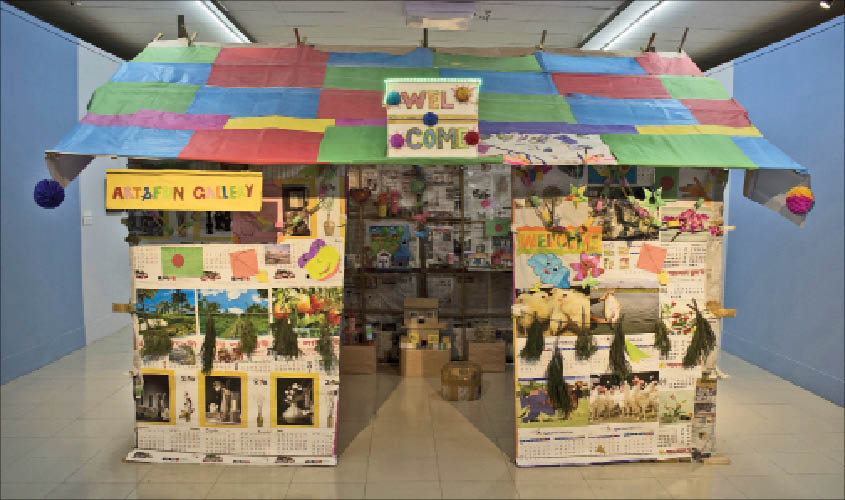Two ongoing shows at different galleries in Delhi feature works by contemporary artists and photographers from Bangladesh, offering a commentary of sorts on the country’s troubled past and its strife-torn present, writes Bhumika Popli.
In August 2018, after the arrest of the internationally-recognised photographer Shahidul Alam, the whole world’s attention was directed at Bangladesh. Alam was picked up by the police from his home on 5 August after an interview with Al Jazeera, for speaking about student protests.
Though the photographer was released on bail in November, his arrest brought Bangladesh into the limelight. The country and its contemporary art are the subjects of two ongoing exhibitions in Delhi. Finger On The Pulse is on view at the Akar Prakar gallery till 11 January, and the other show, entitled (Dis)place is on at the Korean Cultural Centre till 22 February. Each show presents a cultural commentary on issues plaguing contemporary Bangladesh.
“We have been consistently working with Bangladesh for the last ten years through our Kolkata gallery,” Reena Lath, director, Akar Prakar, told Guardian 20. “We have had exchange programmes and have often showcased the works by Bangladeshi artists there. Since we have moved to our Delhi space we wanted to continue with this connection.”
As soon as you enter the Akar Prakar gallery you see a hut made with recycled objects, drawings and calendars. There are also origami artworks, plastic flowers, and poems scribbled on paper inside the hut. This particular installation, entitled Equilibrium Project, is by Marzia Farhana. Children from the age group of 10-12 years from a government school in Bangladesh assisted Farhana in this project.

In an email response, she said, “During my post-graduation in arts in London, I researched on the idea of ‘Social Sculpture’, invented by the German artist Joseph Beuys. Later, after coming back to Dhaka, I was interested in socially engaged art and participatory art. The words by the master artist of Bangladesh, S.M. Sultan inspired me to do this particular project. He once said ‘The kid that draws his village, beautiful flowers, animals and pets, green leaves, foliage and trees, he can’t commit any crime, can’t hurt anybody… Our trend of art should be changed, otherwise how can it be said that the cultivation of art forms and shapes human character?’”
Another installation work at the show, entitled War of Images, by Mizanur Rahman Chowdhury, expands our understanding of the world beyond the usual narratives offered by the mass media. The artist has overlaid magazine covers with cotton, burnt paper, band-aids and other materials to obscure the “ideal images”, just like media houses obscure real issues behind sensationalism.

Artist Dilara Begum Jolly, through her installation entitled War After War, brings to the fore the plight of women in Bangladesh as the country went through a disturbing phase after the 1971 war against Pakistan. She has pierced with needles photographs depicting bombed houses during the war. The needles have roughened the smooth surface of the photographs. According to Lath, the artist has attempted to show that nothing is permanent and everything gets distorted over time. Tanzim Wahab, a Bangladeshi cultural critic, is the curator of both these shows. (Dis)place, at Korean Cultural Centre, has been curated by Wahab with Hadrien Diez, a French curator. Wahab spoke to us about the choice of the exhibition venue. He said, “The works displayed here are actually global in context. We found that the Korean Cultural Centre is an apt place to depict many aspects of Bangladesh as Korea has also suffered dreadful times.”
Both exhibitions bring viewers face to face with the past. (Dis)place includes contact prints by Shahidul Alam. These photographs document different protests across Dhaka in the late 1980s and early 1990s. This was essentially a time when thousands of activists were out on the streets, demanding political reforms.
It is interesting to note that rather than a handful of images depicting street scenes from the past, the curators have brought contact sheets featuring a number of images. The contact sheets are placed with magnifying glasses for a closer view.
For (Dis)place, one needs to carry the catalogue available at the reception to understand the works, which are not tagged with their respective title labels.
Is there an atmosphere of fear among the artists in Bangladesh after Alam’s arrest? Wahab doesn’t think so. “The situation is not scary in Bangladesh. Historically artists in Bangladesh have been vocal about their rights. After all, culture is never static and artists always find their language,” he said.

